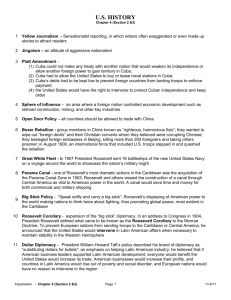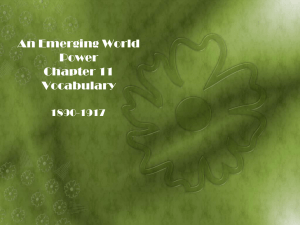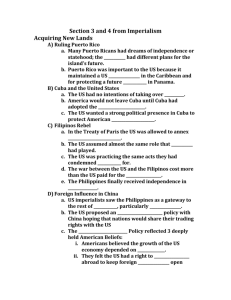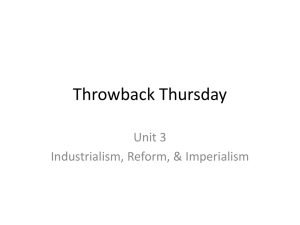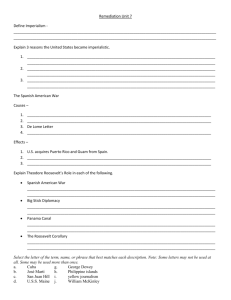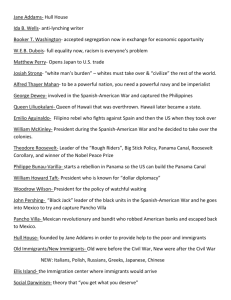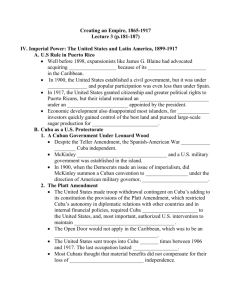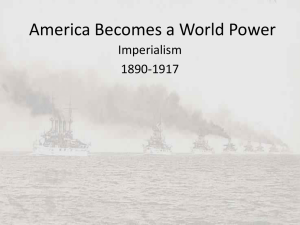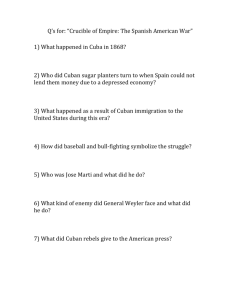Chapter 17 Becoming a World Power
advertisement
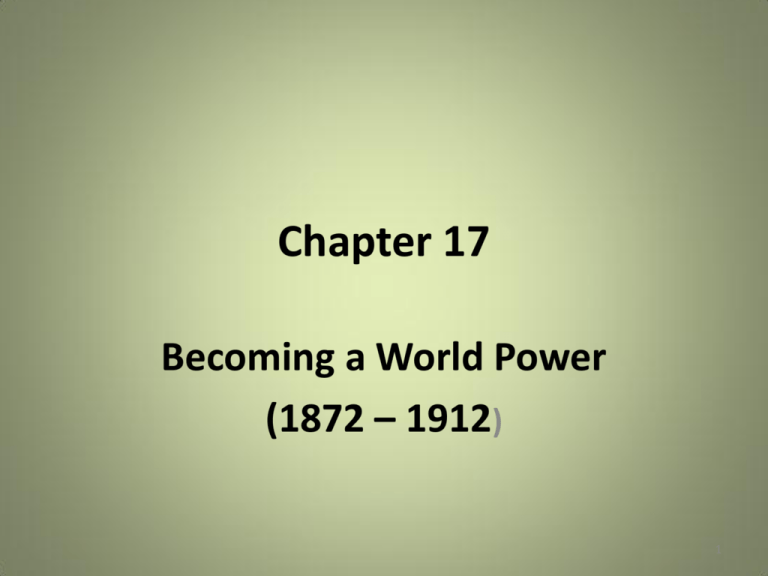
Chapter 17 Becoming a World Power (1872 – 1912) 1 Chapter Overview: • During this era, economic and military competition from world powers convinced the United States it must be a world power. The United States became an empire when it acquired the Philippines and territory in the Caribbean. American influence in Central and South America grew as the United States took a more active role in Latin American affairs. 2 17.1 The Imperialist Vision • This section focuses on the United States becoming an imperialist power. In the late 1800s, many Americans wanted the United States to expand its military and economic power overseas. • • Section 1 Objectives: Following this section I will be able to: • Define: imperialism, protectorate. • Identify: Anglo-Saxonism, Matthew C. Perry, Queen Liliuokalani, Pan Americanism, Alfred T. Mahan, Henry Cabot Lodge. • Analyze how a desire for more trade and markets led to political change between 1877 and 1898. • Cite the motivations for and methods of American expansion in the Pacific. 3 Why did Americans increasingly support imperialism during the 1880s? 4 Imperialism • Beginning in the 1880s, Americans wanted the U.S. to become a world power (had focused on reconstructing the South prior to this) • 3 Reasons: • 1. Economic competition • 2. Military competition • 3. Feeling of cultural superiority • Imperialism: economic and political domination of stronger nation over weaker nations 5 Economic Reasons • Businesses needed raw materials • Develop overseas markets for goods = more customers • Protect American businesses and interests in other parts of the world • Social Darwinists argued that as nations competed for raw materials and customers, only the strongest would survive 6 Military Reasons • Captain Alfred T. Mahan wrote a book, The Influence of Seapower Upon History, 1660-1783 – suggested that a nation needed a large, strong navy to protect its merchant ships and to defend its right to trade with other countries • Large, powerful navy = powerful country • Wanted to acquire territory overseas for naval bases for refueling ships around the world (coaling stations) 7 Cultural Reasons • Anglo-Saxonism: the idea that Englishspeaking nations have superior character, ideas, and systems of government – and they were destined to dominate the planet • Many churches connect ideas of AngloSaxonism with missionary work = spreading Christianity (our religion is superior as well) 8 Where did the U.S. actively pursue power and influence? • Pacific/Asia • Latin America 9 Where we went… • Japan – Economic & Military reasons • Commodore Perry uses naval power to force Japan to trade with U.S. and allow U.S. to use Japan for refueling (buy coal) • Hawaii – Economic & Military reasons • Create a naval base • Planters want to control Hawaii – use threat of force to make Queen Liliuokalani to give up her power – planters set up new government 10 Trade & Diplomacy in Latin America • American business leaders wanted to increase the sale of American products to this region • Wanted Europe to know that U.S. was the dominant power in the region • Pan-American conference held in 1889 to support peace and increase trade among the Americas (known today as the Organization of the American States) 11 Where are we expanding? • The US is primarily concerned with expanding in Latin America and Asia 12 2 Views Anti-Imperialists 1. Enough difficulties at home. 2. Shouldn’t use our armies elsewhere. 3. Racism – (our race is the best). 4. Too many costs – military = more taxes = more debt. 5. Labor – foreigners would compete for US jobs. Imperialists 1. Gain access to raw materials. 2. Strategic – allies for war. 3. Demonstrate US power. 4. Expand our own market – sell our products for profit. 5. American spirit. 13 Graphic Organizer Factors Leading to U.S. Imperialist Policy 14 Graphic Organizer Feeling of superiority Interest in expanding trade Factors Leading to U.S. Imperialist Policy Need for strategic military bases European competition 15 17.2 The Spanish-American War • This section focuses on how the United States became an imperialist power through going to war with Spain. The United State defeated Spain in a war, acquired new overseas territories, and became an imperial power. • Section 2 Objectives: Following this section I will be able to: • Define: yellow journalism, jingoism. • Identify: Jose Marti, William Randolph Hearst, Joseph Pulitzer, Theodore Roosevelt, Platt Amendment. • Describe the circumstances that led to war between the United States and Spain in 1898. • Explain how the war made the United States a world power. 16 The Cuban Rebellion Led US Into War With Spain • Cuba, a Spanish colony, provided wealth for Spain with sugarcane plantations. • In 1868 Cuban rebels declared independence and began a guerrilla attack against Spanish authorities. • At the start of the Cuban revolution, Americans were neutral. • But after reports in two newspapers, the New York Journal owned by William Randolph Hearst and the New York World owned by Joseph Pulitzer, Americans began to side with the rebels. • The newspapers, trying to outdo each other, began to use yellow journalism by running exaggerated stories of 17 Spanish attacks on Cubans. The Cuban Rebellion = U.S. Enters War • Gen. Weyler (the butcher) caused the deaths of tens of thousands of Cuban villagers by sending them to concentration camps. • In February 1898, the U.S.S. Maine, anchored in Havana, Cuba, exploded, killing 266 American officers and sailors. • Although no one knows why the ship exploded, many Americans blamed Spain. Result: • led Americans to call for intervention in the war; Jingoism was present (attitude of aggressive nationalism); = McKinley pressured into declaring war with Spain 18 Yellow Journalism • Newspapers try to compete for profit and ended up exaggerating the SAW. They would lie about stories, captions, or titles. • Americans were pressuring the gov’t to get involved. 19 War on 2 Fronts • The United States Navy’s North Atlantic Squadron blockaded Cuba. • An American fleet in British Hong Kong was ordered to attack the Spanish fleet in the Philippines–a Spanish colony. • Commodore George Dewey led a squadron that destroyed Spanish warships in Manila Bay in the Philippines. • In May 1898, McKinley sent 20,000 American troops to the Philippines and, along the way, seized the island of Guam–a Spanish possession in the Pacific. 21 Meanwhile, Back in Cuba • In June, American troops advanced toward Santiago Harbor in Cuba. • Among the American troops were the “Rough Riders” led by Colonel Leonard Wood, with Theodore Roosevelt as second in command. – Rough Riders led by Roosevelt were the most famous • Made up of cowboys, policemen, college athletes… • Won their great victory after charging up San Juan Hill • (1/4 of the soldiers were African Americans) • Spanish resistance ended with the surrender of Santiago. 22 23 Spoils of War • Treaty of Paris - United States gets Puerto Rico, Guam, Cuba and paid Spain $20 million for the Philippines. • Treaty of Paris made the United States an imperial power. • In 1900 Congress passed the Foraker Act, making Puerto Rico an unincorporated territory (no citizenship). • In 1917 Puerto Ricans were made citizens of the United States. (should P.R. become a state or not?) • Platt Amendment – allows US to oversee government of Cuba and governed relations between the two countries 24 The Platt Amendment The US military occupied Cuba after the war and forced Cuba to write a new constitution. The Cubans accepted in their constitution the Platt Amendment which stated the following: 1. Cuba couldn’t make treaties with other countries. 2. Cuba had to allow the US to buy or lease naval bases on the island (Guantanamo Bay). 3. Cuba had to keep it’s foreign debts low. 4. US had the right to intervene in Cuba to protect it’s independence. 25 Results of US Imperialism • • • • Japan – must trade Alaska – bought it Hawaii – took over Philippines, Guam, Cuba, Puerto Rico – taken from Spain in war. • U.S. emerges as a powerful but resented nation. 26 Spanish-American War Graphic Organizer Factors Contributing to Declaration of War 27 Spanish-American War Graphic Organizer Sinking of the USS Maine Factors Contributing to Declaration of War Sympathy for Cuban revolution Need to protect American investments in Cuba 28 17.3 New American Diplomacy • This section focuses on how the presidency of Theodore Roosevelt helped increase America’s power. Under President Theodore Roosevelt, the United States increased its power on the world stage. • Section 3 Objectives: Following this section I will be able to: • Define: sphere of influence, Open Door policy, dollar diplomacy. • Identify: Boxer Rebellion, “Great White Fleet”, HayPauncefote Treaty, Roosevelt Corollary. • Critique Theodore Roosevelt’s foreign policy as president. • Explain the Open Door policy and its effects on relations between the United State and Asia. 29 Problems in Asia • In 1899 the United States was a major power in Asia. • In 1894 war began between China and Japan over what is now Korea. • This ended in a Japanese victory. • In the peace treaty, China gave Korea independence and Japan territory in Manchuria. 30 Problems in Asia • Japan’s rising power worried Russia. • Russia forced Japan to give back the part of Manchuria to China and later made China lease the territory to Russia. • This leasehold became the center of a sphere of influence, an area where a foreign nation controlled economic development such as railroad and mining. 31 What is a Protectorate? • Local leaders were able to stay in power, and the European Colonial power offered them protection, but the Colonial power had influence over them and their affairs. 32 33 US – Diplomacy - Open Door Policy • President McKinley and Secretary of State John Hay supported an Open Door policy in China. • They believed all countries should be allowed to trade with China. • Hay sent notes to countries with leaseholds in China asking to keep ports open to all nations. • Hay expected all powers would abide by this plan – everyone agreed except CHINA 34 Boxer Rebellion • Secret Chinese societies were organized to end foreign control. • Members of the Boxers started the Boxer Rebellion. • Group members invaded foreign embassies in Beijing and killed more than 200 foreigners and took others prisoner. • An international force stopped the rebellion in August 1900. 35 Roosevelt Becomes President • On September 6, 1901, Leon Czolgosz shot President McKinley, who died a few days later. • Theodore Roosevelt, McKinley’s vice president, became the youngest person to become president. • Roosevelt believed the United States had a duty to shape the “less civilized” parts of the world. • He wanted the United States to become a world power. • The Great White Fleet, 16 battleships of the new United States Navy, was sent around the world to show the country’s military strength – creates tension w/ Japan • Big Stick Diplomacy – show world we are powerful--“Walk softly and carry a big stick.” 36 U.S. Wants Panama • A French company that had begun to build a canal through Panama offered to sell its rights and property in Panama to the United States. • Panamanians decided to declare their independence from Colombia and make their own deal with the United States to build the canal. • The short uprising against Colombia was supported by the United States, which sent ships to Panama to prevent Colombia from interfering. • The United States recognized Panama’s independence, and the two nations signed a treaty to have the canal built. 38 Panama Canal • Construction of the 50-mile canal took ten years. • It shortened the distance from the Atlantic to the Pacific Ocean by about 8,000 nautical miles. • The 1904 Roosevelt Corollary to the Monroe Doctrine stated that the US would block European influence in Latin American – to maintain political & economic stability & control 39 40 41 42 43 U.S. Wants Panama Canal Graphic Organizer Reasons to Build Canal 44 U.S. Wants Panama Canal Graphic Organizer Save time Reasons to Build Canal Save money Help the U.S. remain a world power 45 Taft Becomes President – Deals With Imperialism • The new president of the United States, William Howard Taft, continued Roosevelt’s policies. • He believed that if American business leaders supported Latin America and Asian development, everyone would benefit. • His policy came to be called dollar diplomacy. Taft described his policy as “substituting dollars for bullets”. 46 Roosevelt & Taft Roosevelt’s Policies • Open Door Policy- every nation should be open to trading with China. • Roosevelt Corollary- the US will intervene in Latin America whenever & however it’s necessary. • Panama Canal – US built the canal to help move goods from Atlantic to Pacific faster. See Page 538! Taft’s Policies • $$Dollar Diplomacy – same idea as Roosevelt Corollary. • “Substituting Dollars for Bullets” 47 48 U.S. Actions in the Pacific • Expanded Chinese and Japanese markets • Annexed the Midway Islands as refueling depots for expanded navy • Built coaling stations on Samoan Islands • American business leaders led successful campaign for Hawaiian annexation • Victory over Spain gave U.S. control over Guam and the Philippines 49 U.S. Actions in Latin America • At Pan-American Conference, invited Latin American countries to trade with U.S. • Supported Cuba’s rebellion against Spain, leading to Spanish-American War; victory over Spain gave U.S. control over Cuba & Puerto Rico • Built the Panama Canal • Issued the Roosevelt Corollary stating that the U.S. would intervene in Latin America to maintain stability 50 51
